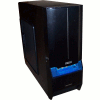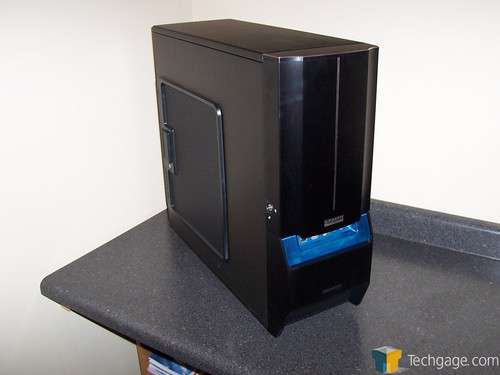- Qualcomm Launches Snapdragon 4 Gen 2 Mobile Platform
- AMD Launches Ryzen PRO 7000 Series Mobile & Desktop Platform
- Intel Launches Sleek Single-Slot Arc Pro A60 Workstation Graphics Card
- NVIDIA Announces Latest Ada Lovelace Additions: GeForce RTX 4060 Ti & RTX 4060
- Maxon Redshift With AMD Radeon GPU Rendering Support Now Available
Gigabyte 3D Aurora 570

Although they are one of the most popular motherboard manufacturers in the world, Gigabyte is not often referred to for their cases. With the 3D Aurora 570, they look to build on the momentum they have with their other products to make an impact in the gamer chassis market.
Page 2 – Unpacking
Once out of the box, we start to see that the Aurora 570 is a large full ATX chassis. For me, this is a good thing. Offering five 5.25†drive bays and a pair of 3.5†FDD bays, the Aurora 570 has more than enough space for any CD, DVD, HD-DVD, Blu-Ray, floppy, fan controller and ZIP drive that you might want to install. Most of us only have a pair of drives and maybe a fan controller but there are those who will appreciate the extra expandability of the Aurora 570. There is also the fact that 5 bays is pretty much standard for most full ATX capable cases but who needs details?
The drive bays are hidden behind an attractive brushed aluminum door that swings open to the right. Just under the door is the I/O ports and on the bottom, there is metal mesh to let the front 120mm fan pull in cooler outside air into the case. Also in this area, there is a unique feature only found on the Aurora 570. Gigabyte has given the user the ability to “project†a logo or text of their choosing onto the desk that the case is sitting on. We will cover this more in depth later in the review.
As stated earlier, the Aurora 570 has the obligatory I/O ports on the front of the case and for the most part, they are easily accessible. There is a single FireWire port, a pair of USB ports, a hard drive activity light and set of microphone and audio out jacks. This area is set in a transparent blue plastic and when powered on, this will glow blue.
With the door open, directly above the I/O ports, the power and reset buttons can be found. I personally like having these behind a lockable door as anyone can come by and reset your machine of they wanted to. Not a huge deal, but something small that I can appreciate. The power button glows blue when the PC is powered on as well.
Speaking of a lockable front door, here is said lock in all its glory.
Moving around to the side of the Aurora 570, Gigabyte took ventilation seriously and the side panel proves this. Where most companies would place a window, Gigabyte has put a black metal screen on the side panel to allow the video card and CPU to get as much outside air as possible. While this looks great as it is, Gigabyte has also included a clear plastic window for those that prefer to see their hardware rather than let it breathe a bit easier.
As with most PC cases, the side panel can be removed with the use of a simple lockable handle. This allows easy access to the inside of the PC should an upgrade or quick fix be needed.
The back of the Aurora 570 offers the same features as almost any other pc case on the market today but with the addition of another 120mm fan. This can be viewed a couple of different ways. This allows the use of a pair of silent fans which push less air but since there are double the fans, twice as much air will be pushed out of the back of the case.
For me, the most attractive use of the double 120mm fans is when water cooling the PC. Most companies that deal in water cooling offer many different 240mm radiators. With the Aurora 570, this radiator can easily be installed and the tubing can conveniently run through the pass through holes on the back and into the case itself.
Just as one would expect, the Aurora 570’s layout is similar to most other PC chassis available. The power supply resides at the top and the motherboard is positioned just underneath. With its nickel plated back, the Aurora 570 definitely looks good from any angle. Also, notice that the fans are not screwed onto the case itself but rather are attached with rubber rings and a push pin. This is to cut down on vibration noises when running.
As stated earlier, at the bottom of the case, just to the right of the PCI slots, there is a pair of rubber rimmed holes. These are to be used of an external radiator is used such as Gigabyte’s own 3D Galaxy II. Again, Gigabyte has demonstrated that they understand what enthusiasts look for in a computer case and have addressed these desires.
To assist the side panel’s handle in keeping the door on the side of the PC, Gigabyte includes thumb screws to be used to secure the panel onto the back of the case. These are nice for quick entry into the inside of the case. This is also a better picture of the way that Gigabyte attached the fans to the back of the case.
Removing the side panel, we get into the inside of the Aurora 570. Lacking a removable motherboard
tray, Gigabyte makes up for this omission with a sturdy tool less design and plenty of room to work. The basic layout of the inside is the same as most cases. The hard drives sit perpendicular to the motherboard and are installed and secured using drive rails.
As the outside of the case showed, Gigabyte has designed the case with a keen eye at the details. One of the worst parts of a DIY PC build is working with the cables once everything is installed. Cable management has given more than a few system builders a headache and Gigabyte knows this. To help combat this, they have used a cable clamp to keep everything together.
|
|
Support our efforts! With ad revenue at an all-time low for written websites, we're relying more than ever on reader support to help us continue putting so much effort into this type of content. You can support us by becoming a Patron, or by using our Amazon shopping affiliate links listed through our articles. Thanks for your support!















